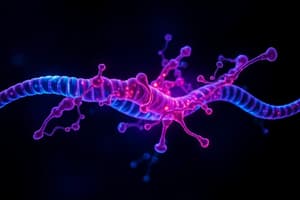Podcast
Questions and Answers
What is the main function of DNA methylation in gene expression?
What is the main function of DNA methylation in gene expression?
- It increases the expression of active genes.
- It facilitates transcription factor binding.
- It promotes histone acetylation.
- It typically leads to gene silencing. (correct)
Which technique uses methylated DNA to specifically enrich for methylated sequences?
Which technique uses methylated DNA to specifically enrich for methylated sequences?
- Histone modification analysis
- Methylated DNA immunoprecipitation sequencing (correct)
- RNA-seq
- ChIP-seq
What effect does histone acetylation have on chromatin structure?
What effect does histone acetylation have on chromatin structure?
- It results in more compacted chromatin.
- It increases the affinity between DNA and histones.
- It directly causes DNA to become methylated.
- It neutralizes the positive charge of lysine residues. (correct)
What is an epigenetic mark?
What is an epigenetic mark?
In the context of histone modification, what do active marks typically signify?
In the context of histone modification, what do active marks typically signify?
Which enzyme is primarily responsible for adding methyl groups to DNA?
Which enzyme is primarily responsible for adding methyl groups to DNA?
What is the consequence of methylation at CpG islands in the promoter region of a gene?
What is the consequence of methylation at CpG islands in the promoter region of a gene?
How does DNMT1 contribute to DNA methylation?
How does DNMT1 contribute to DNA methylation?
What is the effect of DNA demethylation on gene expression?
What is the effect of DNA demethylation on gene expression?
Which of the following statements correctly describes the function of DNMT3b?
Which of the following statements correctly describes the function of DNMT3b?
Flashcards are hidden until you start studying
Study Notes
Altering Chromatin Structures
- Three main processes alter gene transcription: histone modification, chromatin remodeling, and DNA methylation.
Histones
- Nucleosomes consist of an octamer of histone proteins around which 147 base pairs of DNA are coiled.
- Core histones include H2A, H2B, H3, and H4, with H1 acting as a linker protein.
Histone Code
- The histone code is a pattern of post-translational modifications that influencing chromatin state and gene expression.
- Modifications like acetylation, methylation, phosphorylation, and ubiquitination impact functionality and are heritable epigenetic marks.
Active and Repressive Marks
- Active marks facilitate gene expression, while repressive marks silence gene activity.
- The specific covalent modifications depend on the amino acid composition of histone tails.
Histone Acetylation
- Acetylation neutralizes the positive charge of lysine, reducing histone affinity for DNA, allowing for transcriptional activation.
- Histone Acetyltransferases (HAT) add acetyl groups; Histone Deacetylases (HDAC) remove them.
- Hyperacetylation occurs near actively expressed genes.
DNA Methylation
- Methylation, especially within CpG islands, is a well-understood form of epigenetic regulation leading to gene repression.
- 5-methylcytosine (5mC) is the result of methylation, promoting chromatin condensation and blocking transcription factor binding.
- Approximately 1.5% of human DNA is 5mC, significant given that about 2% encodes proteins.
DNA Methyltransferases (DNMTs)
- DNMT1 maintains existing methylation patterns during DNA replication, while DNMT3a and 3b establish new methylation patterns.
- Hemimethylated DNA aids in identifying which strand should be methylated post-replication.
DNA Demethylation
- The removal of methyl groups reverses methylation effects, crucial for epigenetic reprogramming.
- TET proteins (TET1, TET2, TET3) catalyze this process, enhancing transcriptional activation.
Hypomethylation and Hypermethylation
- Hypomethylation results in more active transcription, promoting growth but increasing chromosomal instability.
- Hypermethylation silences genes involved in regulating cell growth, DNA repair, and apoptosis.
Epigenetic Inheritance
- Epigenetic tags can be inherited without changes to the DNA sequence itself, allowing parental experiences to affect offspring.
- Epigenetic alterations may be erased in a zygote but can still be passed down.
Identical Twins and Epigenetics
- Comparisons of DNA methylation patterns in twins show that similar patterns exist in youth, but diverge in older age, demonstrating the influence of environment on epigenetics.
Environmental Impact on Development
- Genetic identicality in bees shows that environmental factors, such as diet (e.g., royal jelly), affect the expression of genes related to worker and queen development through DNA methylation.
Studying That Suits You
Use AI to generate personalized quizzes and flashcards to suit your learning preferences.




